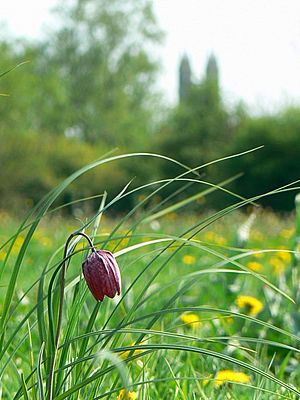North Meadow, Cricklade facts for kids
North Meadow, Cricklade is a special hay meadow found near the town of Cricklade in Wiltshire, England. It covers an area of about 24.6 hectares, which is roughly the size of 34 football fields!
This meadow is managed in a traditional way, much like it has been for hundreds of years. It's known as lammas land. This means that from August 12th to February 12th each year, animals can graze (eat grass) there. Then, the grass is cut for hay, but not before July 1st. This old way of using the land has helped create a home for many different plants and animals.
North Meadow is especially famous for one beautiful flower: the snake's-head fritillary (Fritillaria meleagris). Over 250 types of plants grow here, but the fritillary is the star. About 500,000 of these unique flowers bloom every year in the meadow. This is an amazing 80% of all the snake's-head fritillaries in Britain!
Contents
History of North Meadow
The meadow is located between two rivers, the Thames and the River Churn. The special home for the fritillary flowers was created by regular floods that happen in winter. These floods bring important nutrients to the soil.
Long ago, many meadows like North Meadow were common in Britain. But starting in the 1730s, farmers began to drain and plough them to grow crops. North Meadow was lucky and avoided this fate. It was saved because of an old Saxon system of town government called the Court Leet. This group made sure the land stayed owned by everyone in the community.
Today, Natural England helps manage the land, with support from the Court Leet. You can still see ancient Hay Lot stones in the meadow. These stones once marked the plots of land for local farmers.
In 1971, North Meadow was officially named a biological Site of Special Scientific Interest (SSSI). This means it's a very important place for nature. Part of the site has also been made a national nature reserve. This gives it even more protection.
Plants of North Meadow
North Meadow is home to many different kinds of plants, especially grasses and wildflowers.
Grasses and Meadow Flowers
You can find many types of grasses here, such as:
- red fescue (Festuca rubra)
- perennial rye grass (Lolium perenne)
- meadow foxtail (Alopecurus pratensis)
- crested dog's tail (Cynosurus cristatus)
- yellow oatgrass (Trisetum flavescens)
- meadow brome (Bromus commutatus)
- meadow barley (Hordeum brachyantherum)
The meadow also has many beautiful wildflowers, including:
- pepper saxifrage (Silaum silaus)
- yellow rattle (Rhinanthus minor)
- great burnet (Sanguisorba officinalis)
- black knapweed (Centaurea nigra)
- adder's tongue (Ophioglossum vulgatum)
- common meadowrue (Thalictrum flavum)
- ragged robin (Lychnis flos-cuculi)
- meadow buttercup (Ranunculus acris)
- cowslip (Primula veris)
- meadowsweet (Filipendula ulmaria)
- ox-eye daisy (Leucanthemum vulgare)
Plants Near Water
The rivers, streams, and ditches around the meadow also have their own special plants. These add to the amazing variety of life here. Some of these water-loving plants are:
- slender tufted-sedge (Carex acuta)
- marsh arrowgrass (Triglochin palustris)
- great water-dock (Rumex hydrolapathum)
- tubular water-dropwort (Oenanthe fistulosa)
- marsh marigold (Caltha palustris)
- marsh foxtail (Alopecurus geniculatus)
- early marsh-orchid (Dactylorhiza incarnata)
- brown sedge (Carex disticha)
Animals of North Meadow
With so many plants, it's no surprise that North Meadow is also home to many insects and other animals.
Butterflies and Dragonflies
You can spot many types of butterflies fluttering around the meadow, such as:
- meadow brown (Maniola jurtina)
- common blue (Polyommatus icarus)
- small heath (Coenonympha pamphilus)
- marsh fritillary (Euphydryas aurinia)
The hedges bordering the meadow are also home to butterflies like:
- gatekeeper (Pyronia tithonus)
- ringlet (Aphantopus hyperantus)
- speckled wood (Pararge aegeria)
There are also 14 different kinds of dragonflies recorded here. Some of them include:
- brown hawker (Aeshna grandis)
- black-tailed skimmer (Orthetrum cancellatum)
- ruddy darter (Sympetrum sanguineum)
Other Animals
The common frog is also very common in the meadow, especially near the wet areas.
Birds of North Meadow
The meadow supports many different kinds of birds.
- In the hedges around the meadow, you might see great tits, blue tits, common chaffinches, linnets, and treecreepers.
- Near the rivers and ditches, look for grey wagtails, reed buntings, sedge warblers, swallows, sand martins, and swifts.


